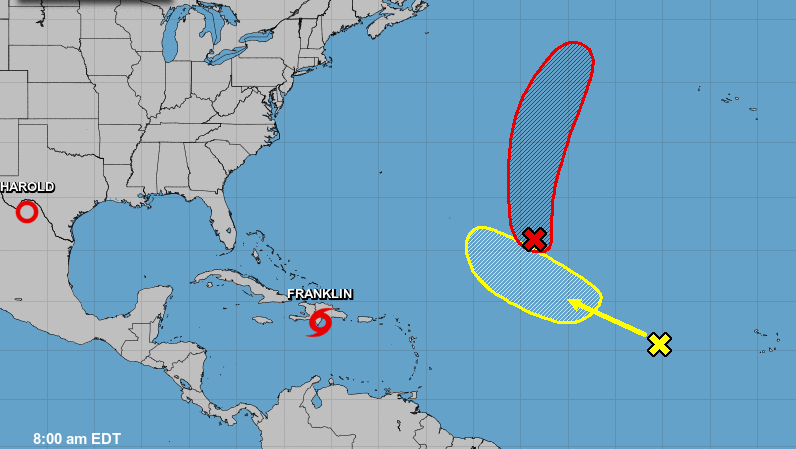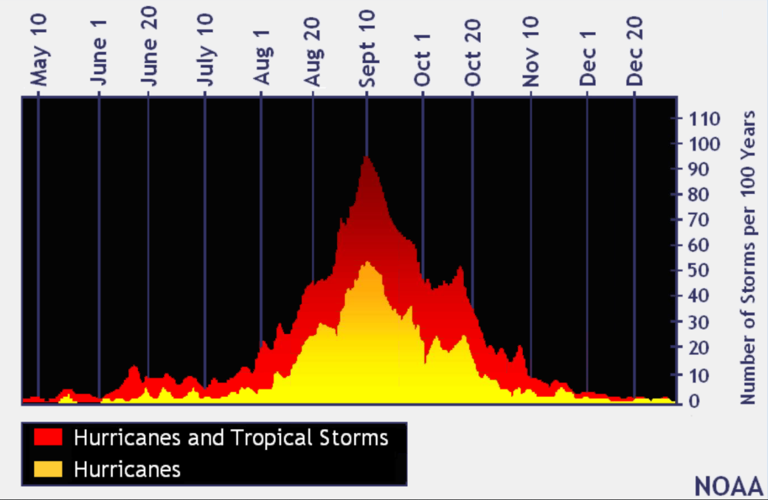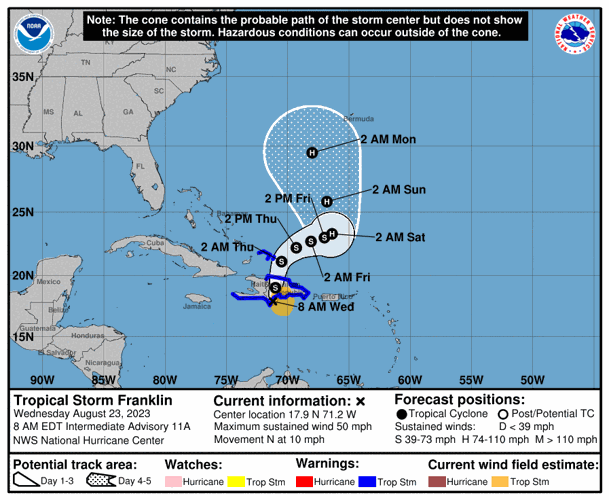Tropical Storm Harold quickly weakened after it made landfall in Texas Tuesday as the first named storm to hit the U.S. this Atlantic hurricane season, forecasters said Wednesday morning.
Now situated over northern Mexico, Harold is producing maximum sustained wind speeds of 30 mph as it moves west-northwest inland at 14 mph. Harold is expected to continue producing heavy rainfall in portions of south Texas and northern Mexico throughout the rest of the day.

Tropical Storm Harold made landfall in Texas on Tuesday, Aug. 22, 2023.
A flood watch is in effect across portions of the Trans-Pecos and Big Bend regions of Texas, where Harold is expected to produce between 1 to 2 inches of rain. Northern Mexico can expect to see 4 to 6 inches of rain today, forecasters said, which could lead to flash flooding and landslides.
Harold formed in the Gulf of Mexico early Tuesday as one of several disturbances spiraling through the Atlantic Ocean. It hit Padre Island, Texas, between Port Mansfield and Corpus Christi at around 10 a.m. with maximum sustained wind speeds of 50 mph, National Hurricane Center forecasters said.
Forecasters first spotted the disturbance that later became Harold on Aug. 16.
Tropical Storm Harold has officially made landfall on Padre Island, TX! Worst has arrived here in Corpus Christi pic.twitter.com/ayeo7DGRFp
— Chris Bruin (@TWCChrisBruin) August 22, 2023
Tropical Storm Franklin
Tropical Storm Franklin made landfall in the Dominican Republic early Wednesday with maximum sustained wind speeds of 50 mph and heavy rains, according to the National Hurricane Center.
Tropical storm warnings are in effect in portions of the Dominican Republic, Haiti and the Turks and Caicos Islands.
Franklin is expected to dump about 5 to 10 inches of rain on Hispaniola in the next day, which forecasters said could cause potentially life-threatening flash and urban flooding and mudslides. Around 1 to 2 inches of rain are expected in Puerto Rico.
The storm is expected to weaken some as it crosses Hispaniola today, but forecasters said it will likely regain strength when it emerges over the southwestern Atlantic later today.
Franklin formed Sunday night.

Other disturbances
Tropical Storm Emily formed early Sunday but quickly degenerated Monday as it hit unfavorable atmospheric conditions, hurricane forecasters said. Emily's remnants are currently located several hundred miles east-northeast of the Leeward Islands, where the system is producing showers and thunderstorms.
Forecasters said the system is likely to regenerate into a tropical depression or storm within the next few days as it moves north over the subtropical central Atlantic. It now has a 70% chance of forming within the next week.
The chances that a tropical wave west of Cabo Verde will form are slowly decreasing as the system heads west-northwest over the central Atlantic. The wave is producing showers and thunderstorms as it moves toward conditions that appear only marginally conducive to some development early next week, forecasters said. It has a 30% chance of forming in the next week, down slightly from Monday's prediction.
The busiest time of hurricane season
We're officially entering what is historically the most active period of the Atlantic hurricane season, so consider this your reminder to get prepared and stay vigilant.
In the last 100 years, the tropics have been busiest from mid-August through October, with Sept. 10 being the peak of the season, according to federal forecasters. About 80% of the systems that have hit the Gulf Coast formed during this time, according to the National Weather Service of New Orleans.

In the last 100 years, the tropics have been the most active in August, September and October, with Sept. 10 being the peak of the Atlantic hurricane season, according to federal forecasters. (graphic via NOAA)
The 2023 hurricane season
The return of El Niño was expected to bring a wetter second half of the year to Louisiana and a reduced risk of hurricanes.
The National Oceanic and Atmospheric Association's Climate Prediction Center announced March 9 that La Niña, which usually causes more hurricanes to form in the Atlantic, was officially over after an unusually long three years.
El Niño and its sister La Niña are part of the El Niño-Southern Oscillation cycle, a set of conditions over the Pacific Ocean that affects weather patterns across the world. In Louisiana, the biggest effects involve hurricane season in the Atlantic Ocean.
Regardless, this year's first cyclone hit in January, long before the official start of hurricane season, and June alone saw three named storms. Now forecasters are predicting that 2023 will prove to be an above-average hurricane season, with 18 named storms.
The first tropical storm to form in the Atlantic this year was named Arlene, reaching wind speeds of 40 mph on June 2 as it headed for Cuba. Don was the first storm to reach hurricane status in 2023, producing maximum sustained wind speeds of 75 mph on July 22 before rapidly weakening to a tropical storm the following day.
Emily, Franklin, Gert and Harold will be followed by Idalia, Jose and Katia. Here's the full list of this year's storm names.
Don't miss a storm update this hurricane season. Sign up for our free Hurricane Center newsletter.





